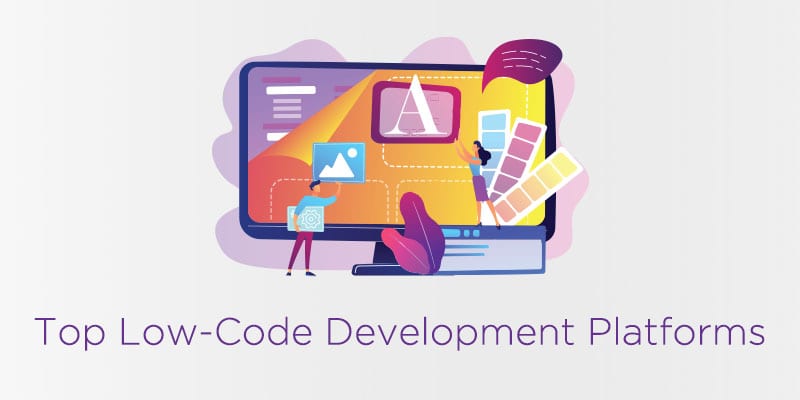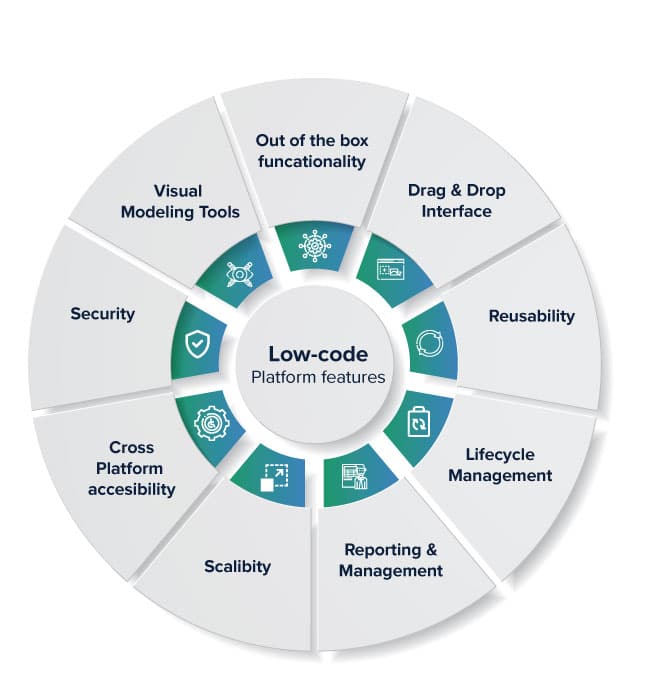Great News To Picking Low-Code Platform Info
Great News To Picking Low-Code Platform Info
Blog Article
Benefits Of Developing Applications Using Low-Code In Terms Of Accessibility For Non-Developers
Due to a number of factors due to a variety of factors, low-code development is easier to non-developers. These are sometimes referred to as "citizens developers."
Drag-and-Drop Builders : Low-code platforms offer drag-and–drop interfaces which enable non-developers, without the requirement to write code to develop visually-based applications. This makes the process of development easier for those with little or no technical skills.
WYSIWYG editors: These "What You See Is What You Get" editors allow users to create interfaces and workflows that look like the final product. This makes it simpler to learn and use.
Simple Logic and Workflow
Visual Workflow Modeling: Users can develop business procedures and logic applications by using visual flowcharts or models. This is much more simple than traditional programming methods.
Pre-built Logic Components: Low-code platforms typically contain pre-built logic components (e.g., conditional statements, loops) that can be easily modified, eliminating the need for complicated programming.
Reusable Components and Templates
Library of Pre-built Templates: Numerous low-code platforms have templates for common applications that allow non-programmers to begin with a solid foundation to customize as needed.
Reusable widgets and modules by using reusable widgets or modules users can speed up the creation process, by reducing the requirement for detailed technical know-how.
Guided Development Tutorials and Guided Development:
Step-by -Step Instructions: Platforms usually provide tutorials that are on screen, guided development pathways, and other tools to help non-developers create applications.
Interactive Tutorials Interactive tutorials that are hands-on and interactive assist users in learning by doing, improving their comprehension and confidence using the platform.
Integration with existing tools
Seamless Integration: Low-code platforms have been designed to be easily integrated with existing tools for business and systems (e.g. CRM, ERP and ERP) which allows non-developers to create applications that work within their current workflows.
APIs and Connectors: APIs built-in and connectors allow non-developers and users to easily connect applications to external services without the need for complicated coding.
Collaboration Features:
Team Collaboration: Features such as real-time collaboration workspaces and shared workspaces make it feasible for non-developers to effectively collaborate with developers, business analyst, and other stakeholders.
Role Based Access Control You can assign non-developers roles with the appropriate access level, so that they can participate in the development process while not compromising on security or functionality.
Automated Testing and Debugging
Low-code platforms are usually equipped with debugging and testing software that automatizes these processes. This makes it easier for non developers to verify their applications work correctly.
Error Highlighting When problems occur, the platform highlights these and offers possible solutions. It guides non-developers in solving the issue.
The capability of low-code apps to make development accessible for non-developers is its biggest benefit. Low-code platforms offer intuitive, visual tools, guided experiences and enable business users actively participate in creating, maintaining and updating applications. See the top official source for Low-code Platform for application development for website tips including rapid app development, paas service, develop cross platform mobile app, mobile app development platforms, rapid applications, cross platform mobile development, rad development, application modernisation, push alerts, develop mobile application and more.
Flexibility And Scalability Are Two Benefits Of Low Code Application Development
Low-code development of applications offers a variety of advantages regarding scalability and flexibility, which are crucial for building applications that adapt to business demands and change with the demands of business. Here are a few of the principal benefits rapid scaling:
Cloud-Based Platforms: A lot of platforms that support low-code are cloud-based. They allow applications to grow quickly and smoothly using the cloud infrastructure. This allows businesses to handle the increased workload without worrying about server management.
Auto-Scaling Functions: Auto-scaling features can be utilized to automatically adjust resources according to demands. They ensure that the performance remains consistent even during peak times.
Flexible Architecture:
Modular Design: Low-code platforms support modular design of applications, in which components can be independently developed test, scaled, and then redesigned. Modularity improves flexibility and it is easier to modify specific elements of an app without having to change the whole system.
Microservices Architecture: Microservices architecture enables the development of applications using a loosely coupled collection of services. This improves scalability & flexibility.
Customizable Solutions:
Flexibility : Low-code platforms permit developers to enhance functionality beyond the standard features. This allows developers to satisfy their own business needs without restrictions.
Third-Party Integrations: The integration of third-party services, APIs or other services enables companies to expand the capabilities of their applications by adding additional functionalities.
Agile Development & Deployment
Continuous Deployment and Delivery Low-code platforms can be used to implement agile processes, allowing continuous deployment and integration (CI/CD). This allows for the rapid release of new features and updates, while ensuring that the applications are able to evolve rapidly as a result of user feedback and market changes.
Iterative Development: The nature of low-code development implies that applications can be incrementally improved and expanded, reducing risks of large-scale changes and allows for greater control over growth.
Resource Optimization
Effective Resource Management: Low-code systems allow you to optimize resource usage by providing tools for monitoring and managing application performance. This helps ensure that resources are utilized efficiently and are easily scaled according to the needs of the user.
Load Balancing : The integrated load balancing function distributes workloads equally among servers. This improves the system's capacity to handle high traffic, and ensures the same performance.
Global Reach
Multi-Region: Low-code platform deployments are frequently supported across multiple geographies which allows businesses to offer users with low latency access to every user. This is especially important when it comes to applications that have a worldwide user base.
Support for Localization The built-in support for localization allows applications to be easily customized to suit different languages and the requirements of diverse markets.
Updates and maintenance:
Low-code software is visually appealing and are modularly built, which simplifies maintenance. Updates and bug fixes are done quickly and without a lot of downtime.
Version Control: Integrated version control software helps control changes and roll backs. This means that updates can easily be installed and older versions restored when needed.
Cost Efficiency:
Low development costs. Through the reduction of coding requirements, low-code platform platforms reduce the cost of development and enable applications to be scaled up without requiring more development effort.
Pay-As-You-Go Models A lot of low code platforms provide flexible pricing for their services, including the pay-as-you go model that aligns costs to actual usage and growth. This gives financial flexibility.
The majority of low-code applications developers provide a lot of flexibility and scalability which lets businesses quickly create robust and flexible apps. These platforms are able to quickly adapt to the changing needs, make efficient use of resources, and continually improve, allowing applications as well as businesses to expand and grow. Check out the top rated wavemaker.com coding for more info including microsoft azure sql, app development platform, application modernization, build with docker, developing mobile apps, push notifications android, application modernization software, push notifications android, paas service, lowcode no code and more.
The Advantages Of Low-Code Development For Developing Applications With Respect To The Limitations And Customization
Low-code design for applications is an equilibrative, flexible method that addresses the limitations of the system and allows for customisation. These are the major advantages: Resolving Limitations
Overcoming Complexity:
Simplified development: Low code platforms make it easier to develop by offering templates and pre-built components. This helps speed up applications to be deployed, even complex ones.
Many platforms have wizards and workflows that are guided to aid developers in understanding complex procedures. These tools reduce the chance of making mistakes, and also help to ensure uniformity.
Scalability Solutions
Scalability Built-In Lowcode platforms usually have features that enable an scalable architecture. They enable applications to handle growing loads without major changes.
Performance Monitoring: The instruments which monitor and optimize performance assist to ensure that applications are efficient, even when they grow.
Security and compliance
Integrated security features Low-code platform comes with built-in measures of security, such as encryption. Access control based on role and automated compliance check to address the most prevalent security issues.
Regular Updates: Platforms often upgrade their security protocols and compliance policies. This makes sure that applications remain secure from new threats.
Features of Customization:
Extensibility:
Low-code platforms allow developers to expand functionality beyond what is available by using custom code.
Custom Plugins and Moduls Developers can create custom plug-ins or modules that offer specific functions tailored to the unique requirements of a business.
APIs and Integration:
API Support: Comprehensive API support allows seamless integration of external systems and services. This allows for the ability to customize and connect.
Third-Party Applications Lowcode platforms are usually built with connectors for third-party apps, making it easier to integrate them and modify the application.
Flexible UX/UI Designs:
Customizable User Interfaces: Developers can modify and design user interfaces to meet specific specifications for branding and usability and provide a customized user experience.
Responsive Design The built-in capabilities of responsive design make sure that apps can be tailored to various screen sizes and devices.
Business Logic Customization
Visual Workflow Designers: These tools allow you to modify and design workflows as well as business logic, which allows developers to create complex tailored processes.
Platforms come with conditional Logic which permits the creation of custom scripts that address specific scenarios and business rules.
Data Management
Custom Data Modelling: Developers create custom models that meet particular requirements of the application. They can customize data handling to the business's specifications.
Advanced Data Processing: Integration of advanced tools and capabilities for data processing allows customizations in the way data is processed in an application.
Balance between Customization and Limitations
Frameworks, Standards and Standards:
Low-code platforms conform to industry standards and best practice. This helps maintain secure and high-quality applications.
Governance Frameworks - Built-in governance frameworks ensure that customizations don't interfere with security, integrity or compliance.
Feedback and Iterative Design
Rapid prototyping. Developers can develop and refine applications based upon user feedback.
Continuous Improvement: Platforms using low-code support for continuous improvement, allowing customization and enhancement when the requirements of business evolve.
User Empowerment
Empowering Citizen Entwicklers In giving non-developers the capability to personalize their apps using simple interfaces and low-code platforms, they can increase the number of contributors who are able to improve and tailor application.
Support and training: A lot of platforms include extensive training resources as well as support services to help users in creating customizations that work without compromising an application's performance or stability.
In general, low-code application development is a strong framework that can address the weaknesses and provides a wide range of customization opportunities. This allows businesses to build and maintain apps that function, are tailored to their particular requirements and adhere to high standards in terms of quality, security, and scaling.